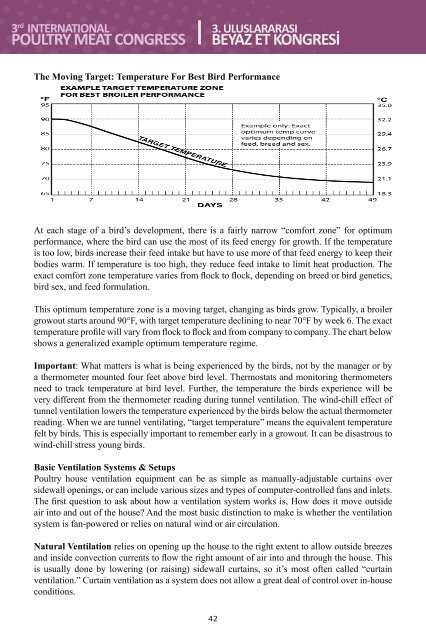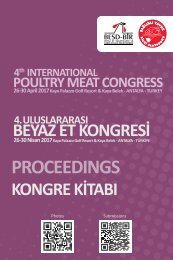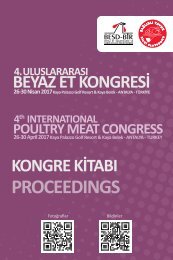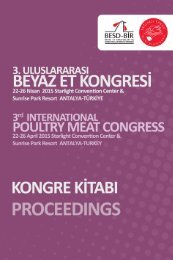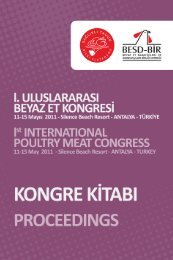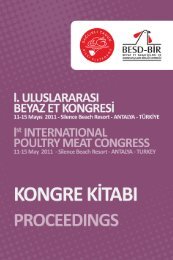3rd International Poultry Meat Congress
Proceedings
Proceedings
You also want an ePaper? Increase the reach of your titles
YUMPU automatically turns print PDFs into web optimized ePapers that Google loves.
The Moving Target: Temperature For Best Bird Performance<br />
At each stage of a bird’s development, there is a fairly narrow “comfort zone” for optimum<br />
performance, where the bird can use the most of its feed energy for growth. If the temperature<br />
is too low, birds increase their feed intake but have to use more of that feed energy to keep their<br />
bodies warm. If temperature is too high, they reduce feed intake to limit heat production. The<br />
exact comfort zone temperature varies from flock to flock, depending on breed or bird genetics,<br />
bird sex, and feed formulation.<br />
This optimum temperature zone is a moving target, changing as birds grow. Typically, a broiler<br />
growout starts around 90°F, with target temperature declining to near 70°F by week 6. The exact<br />
temperature profile will vary from flock to flock and from company to company. The chart below<br />
shows a generalized example optimum temperature regime.<br />
Important: What matters is what is being experienced by the birds, not by the manager or by<br />
a thermometer mounted four feet above bird level. Thermostats and monitoring thermometers<br />
need to track temperature at bird level. Further, the temperature the birds experience will be<br />
very different from the thermometer reading during tunnel ventilation. The wind-chill effect of<br />
tunnel ventilation lowers the temperature experienced by the birds below the actual thermometer<br />
reading. When we are tunnel ventilating, “target temperature” means the equivalent temperature<br />
felt by birds. This is especially important to remember early in a growout. It can be disastrous to<br />
wind-chill stress young birds.<br />
Basic Ventilation Systems & Setups<br />
<strong>Poultry</strong> house ventilation equipment can be as simple as manually-adjustable curtains over<br />
sidewall openings, or can include various sizes and types of computer-controlled fans and inlets.<br />
The first question to ask about how a ventilation system works is, How does it move outside<br />
air into and out of the house? And the most basic distinction to make is whether the ventilation<br />
system is fan-powered or relies on natural wind or air circulation.<br />
Natural Ventilation relies on opening up the house to the right extent to allow outside breezes<br />
and inside convection currents to flow the right amount of air into and through the house. This<br />
is usually done by lowering (or raising) sidewall curtains, so it’s most often called “curtain<br />
ventilation.” Curtain ventilation as a system does not allow a great deal of control over in-house<br />
conditions.<br />
42


